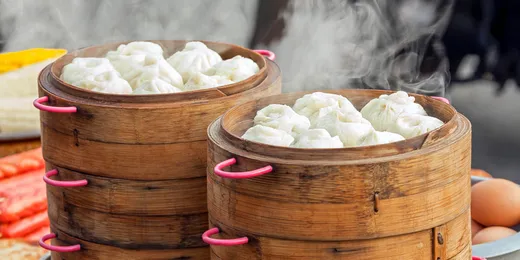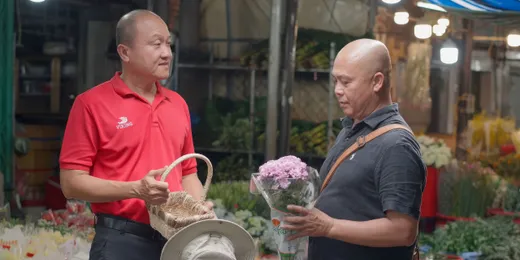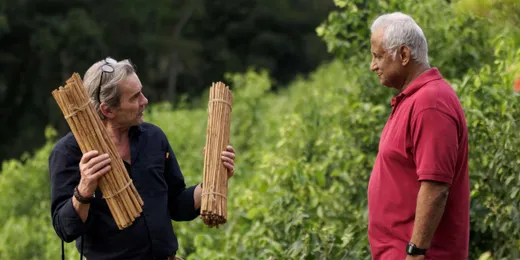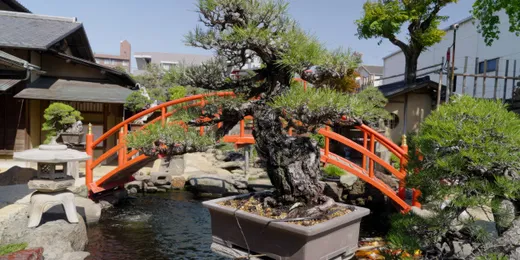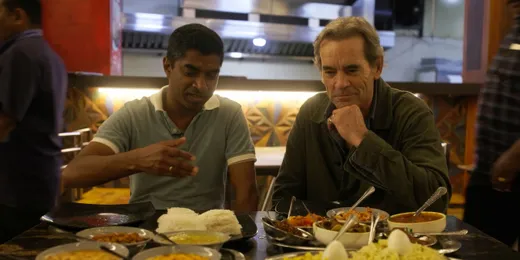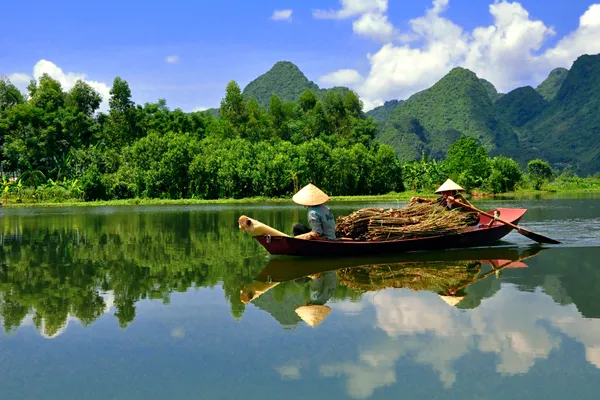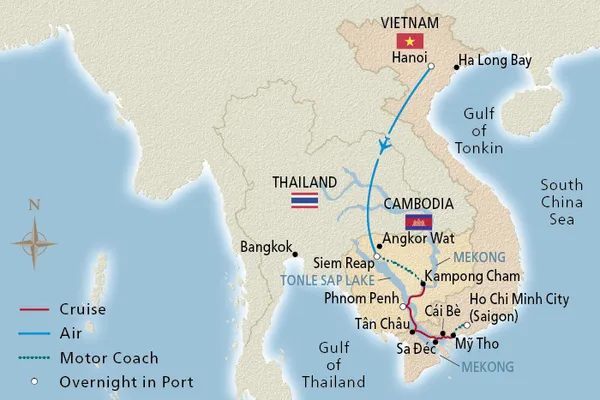
Set sail for Asia
Immerse yourself in Asia’s captivating history & traditions. Read on to learn more about the distinctive countries that comprise this storied region and uncover the unforgettable experiences that await you in Japan, Cambodia, Indonesia and beyond. Discover the fresh ingredients used to prepare Vietnamese summer rolls, trace the history of China’s tea culture and explore why Thailand is an ideal destination for nature enthusiasts.

Asia
Asia is the world’s largest and most diverse continent, occupying four-fifths of the Eurasian landmass, or approximately 17.2 million sq mi. (44.6 million sq km). Asia possesses the longest coastline of any continent, contains both the highest and lowest points on Earth’s surface and has the widest climatic extremes. As a result, Asia produces the largest variety of vegetation and animal life of any continent. For example, Siberia has warm but short summers and long, intensely cold winters, while Southeast Asia has a tropical climate that is hot and humid year-round. Overall, the majority of Asia has a continental climate, characterized by an extreme annual range of temperature across seasons.
Asia is the birthplace of several of the world’s major religions and hundreds of minor ones. As such, this region is home to historic temples, iconic landmarks and cultural treasures including:
- Tokyo’s Meiji Jingu, a Shinto shrine dedicated to the deified spirits of the first emperor of modern Japan and his wife, Empress Shōken
- China’s impressive Terra Cotta Warriors in the ancient, fortified city of Xian
- Hong Kong’s Wong Tai Sin Temple, a colorful Taoist shrine located in the heart of the city
- Potala Palace in Tibet, a 13-story structure that was home to the Dalai Lama for more than 1,000 years
- Angkor Wat in Cambodia, a 12th-century temple that is now a UNESCO World Heritage Site
- Jade Emperor Pagoda, an ornate sacred site in Vietnam’s vibrant Ho Chi Minh City
- Ayutthaya, Thailand’s majestic ancient capital and a UNESCO World Heritage Site
- Indonesia’s Komodo National Park, home to the largest living lizard species, the remarkable Komodo dragon
- Gardens by the Bay, Singapore’s futuristic horticultural park featuring more than one million plants

-
Cuisine—Vietnamese summer rolls (gỏi cuốn)
A worldwide culinary favorite, Vietnamese summer rolls—also known as spring rolls—are one of Southeast Asia’s best-known dishes. Beloved by locals seeking to stay cool during hot, humid weather, these chilled rolls are healthy, filling and portable. No matter when or where you enjoy them, summer rolls offer a taste of Vietnam’s proud culinary heritage. This light, delectable appetizer is packed with local ingredients from the Mekong Delta and South China Sea.
Vietnamese summer rolls—or gỏi cuốn, which translates to “salad roll”—showcase the finest products available from the region’s rice fields and floating markets. A typical preparation includes carrots, cucumbers, shrimp, peanuts, vermicelli noodles and fresh herbs rolled inside a rehydrated sheet of rice paper. This flavorful dish is served chilled with a spicy dipping sauce.
Summer rolls likely originated in China during the Jin Dynasty (266–420 AD) and were consumed to commemorate the first day of spring. By the end of the 3rd century, the Chinese had introduced the dish to Vietnam, and the rolls were adapted to suit Vietnamese palates.
-
Culture—Chinese tea traditions
The history of tea in China is long and complex, given that the Chinese have enjoyed tea for millennia. Scholars hailed the brew as a cure for a variety of ailments, the nobility considered the consumption of good tea as a mark of their status and the common people simply enjoyed its flavor. In 2016, the earliest known physical evidence of tea was discovered in the mausoleum of Emperor Jing of Han (d. 141 AD) in Xian. Tea then became a popular drink in the Tang (618–907) and Song (960–1279) Dynasties.
This article highlights two central components of China’s rich traditions surrounding tea: the ceremony of “Gongfu Cha” and the sophisticated porcelain for which the country has been known for centuries.
The origins of tea ceremonies
For centuries, steaming tea leaves was the primary method used in the preparation of tea. The Chinese learned to process tea in a different way in the mid-13th century, when tea leaves began to be roasted rather than steamed. This is the origin of today's loose teas and the practice of brewed tea.
Traditional Chinese tea ceremonies, known as “Gongfu Cha,” are a refined and intricate practice that emphasizes the art of brewing and appreciating tea. Originating during the Song Dynasty, these ceremonies involve a series of precise steps, including the selection of high-quality tea leaves, the use of specialized teaware and the careful control of water temperature and brewing time. The process is often performed in a serene and contemplative setting, allowing participants to savor the aroma, taste and appearance of the tea. Gongfu Cha is not only a social activity but also a cultural expression that reflects the values of harmony, respect and tranquility in Chinese society.
Traditional Chinese porcelain
Ceramics of all types have been important in Chinese culture for millennia. Porcelain’s initial creation date continues to be up for debate, but scholars believe that it began during the Sui Dynasty (581-618 AD).
Porcelain is a high-firing white clay bodied ceramic, which is usually pure white due to the high content of a clay component known as kaolin. These characteristics allow for the creation of white porcelain of finer, thinner and lighter-weight vessels—perfect for the application of colorful glaze designs.
Porcelain became the object of desire first by emperors, later the wealthy Chinese merchants, and eventually Europeans and North Americans in later centuries. The imperial kilns at Jingdezhen, where porcelain may have been produced as early as the 6th century, created extremely fine porcelain from the 14th century onwards.
Once the clay has been prepared, shaped or molded by hand, it is glazed, either with a solid color or perhaps more intricately decorated with a hand-drawn design of one or more colors. The glazed pots are then loaded into a kiln and fired at a much higher temperature than other stoneware or earthenware.
-
Nature—Thailand, an ideal destination for outdoor experiences
Thailand offers a wealth of natural beauty, especially near destinations such as Bangkok and Phuket. In the heart of Bangkok itself, Lumpini Park offers visitors a green oasis perfect for a leisurely stroll or a picnic. Near Phuket, Kata Beach and Patong Beach are famous for their soft sands and clear waters, ideal for relaxation and water activities. Nature enthusiasts can also explore Phuket Elephant Sanctuary, where rescued elephants roam freely in their natural habitat. For a unique experience, visit Phuket’s Monkey Hill, where you can interact with playful monkeys and enjoy panoramic views of Phuket Town.
Thailand is also home to several notable national parks. Established in 1962 as Thailand’s first national park, Khao Yai National Park is now a UNESCO World Heritage Site. Situated 109 mi. (175 km) from Bangkok, it features lush forests, diverse wildlife and stunning waterfalls. It is one of the few places in Thailand where wild elephants still survive. Thailand’s largest national park, Kaeng Krachan National Park, offers breathtaking views, ample hiking trails and abundant wildlife. Notable mammal species include elephants, bears and leopards. There are also more than 400 bird species, making it a birdwatcher’s paradise.
Asia Highlights
A trip to Asia offers an unparalleled opportunity to discover intriguing cultures and astounding beauty across this fascinating region. Here are some compelling reasons why Asia is worth considering as a destination:
- The serene ritual of tea preparation
- Historic landmarks & modern architecture
- Verdant green spaces in the heart of urban centers
- Fermented rice spirits, like soju & sake, or rice wine
- Spectacular temples & ancient shrines
- Lively street markets offering delectable treats
Destination Insight Videos
-
Food in China (2:10)
Venture into a Chinese night market to sample some of China’s most beloved delicacies. Join Karine and discover the secrets of hot pot, Peking duck, homemade noodles and more.
-
Chinese Porcelain (3:53)
Join Karine as she learns about the history of Chinese porcelain, an art form created during the Han Dynasty and shaped by artisans from the Song, Ming and other dynasties.
-
At Home in Ho Chi Minh City (13:38)
Join Viking Saigon Program Director, Ut Lam Thanh, for an introduction to the vibrant streets of Ho Chi Minh City, Vietnam’s largest metropolis. Immerse yourself in the sights and sounds of the iconic Bến Thàn Market and admire colorful blooms at Ho Thi Ky’s fresh flower market. Then, delve into the rich cultural heritage of Chinatown's Hao Sy Phuong Alley—a charming, centuries-old community of more than 200 households.
-
Alastair Miller in conversation with Dilhan and Malik Fernando of Dilmah Tea (17:30)
Alastair Miller is joined by Dilhan and Malik Fernando, the sons of Dilmah Tea founder Merrill J. Fernando, for an insightful interview about the brand’s mission to bring fresh, ethically produced Sri Lankan tea to the world. Learn more about Dilmah’s business philosophy and why the brand’s loose-leaf teas are served on board Viking’s fleet. Later, during a tour of the Dilmah Tea Plantation and Factory, discover the traditional process of hand-picking, grading and producing premium teas and uncover the delicate art of cultivating pure cinnamon.
-
Explore Japan’s capital city of Tokyo with Alastair Miller (14:15)
Join British photographer Alastair Miller as he tours the vibrant city of Tokyo, where tradition meets futuristic innovation. On his journey, he visits the Tokyo Skytree, one of the tallest structures in the world, where staff share insights into its design and sweeping views across the capital. He also finds tranquility at the Shunkaen Bonsai Museum, guided by a student caretaker, who introduces the centuries-old art of Bonsai and its deep spiritual meaning.
-
Immerse yourself in Colombo’s landmarks and discover Sri Lankan cuisine (15:14)
Follow along as Alastair Miller tours Colombo, the colorful capital of Sri Lanka. His day of exploration begins with a ride on a tuk-tuk, a small, three-wheeled motorized vehicle. He stops at the striking Red Mosque—formally known as Jami Ul-Alfar Mosque—a red-and-white striped structure renowned for its Indo-Saracenic architecture. He then indulges in a traditional Sri Lankan breakfast of string hoppers, a flavorful meal centered around idiyappam—thin, steamed rice noodles that are pressed into flat discs and topped with curry or relish. Alastair’s day ends in a local chef’s kitchen for a hands-on cooking lesson, where he learns how to prepare authentic shrimp curry.
Asia Travel FAQ
All-Inclusive Itineraries—Asia
Choose one of our enriching, all-inclusive voyages and discover the many benefits of exploring in Viking comfort.



